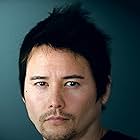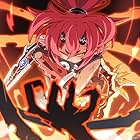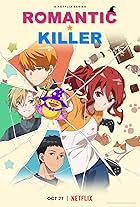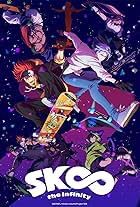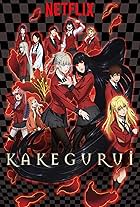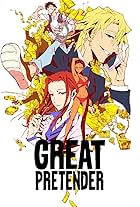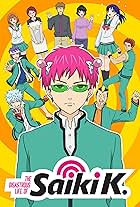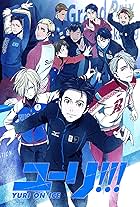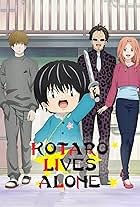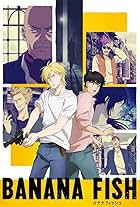IMDb RATING
7.7/10
3.9K
YOUR RATING
Bored with life, popular high schooler Yatora Yaguchi jumps into the beautiful yet unrelenting world of art after finding inspiration in a painting.Bored with life, popular high schooler Yatora Yaguchi jumps into the beautiful yet unrelenting world of art after finding inspiration in a painting.Bored with life, popular high schooler Yatora Yaguchi jumps into the beautiful yet unrelenting world of art after finding inspiration in a painting.
Browse episodes
Netflix's Anime Series and Movies, Ranked
Netflix's Anime Series and Movies, Ranked
We've rounded up every anime series and movie we could find — created or distributed by Netflix — to see which ones rank the highest, according to IMDb users.
Storyline
Did you know
- ConnectionsRemade as Blue Period (2024)
Featured review
The anime industry's default approach to beloved manga adaptations is to drain them dry of personality, rip their hearts out, and factory-produce them for a market that rewards quantity over quality. Blue Period comes out of the machine an uneven but worthwhile experience regardless of all this.
Yatora Yaguchi is a condescending high school student who prides himself on hard work, rather than relying on natural talent. At the very beginning, he sees a Picasso painting and says to himself smugly, "I could paint that." If you've never picked up a paintbrush, that's an understandable conclusion to reach. After all, people who are good at art are just talented, right? Blue Period strives to destroy this misconception at every chance it gets. The author wanted passionately to convey that art takes time, effort, and a strong work ethic. An unfortunate side effect of condensing a lengthy manga into a measly adaptation is cut content at the expense of this one crucial theme. Despite Blue Period's technical faults, and there are many, its character writing rises to the occasion. Like Yatora, each of their lives is well detailed: We know what motivates them, their concerns about getting into art school, how their family feels about their decisions and all of the turmoil that comes from pursuing their dreams. The show's most compelling theme is talent versus hard work.
In a show about art, there's not enough screentime devoted to the process of creating art. And for an anime about artists, it's about as creatively vacuous as manga adaptations come. Even the untrained eye will notice this anime's an eyesore at times. Nothing is captivating about the visual language. There are no inventive directing choices; every background is drab, unimaginative storyboards, and the editing is lifeless. The character designs aren't very detailed yet they're inconsistently animated. They move like stiff cardboard. The close-ups fail to convey the script's intense emotions because they're flat. Unmoving. Likely they copied shots directly from the source material without considering how color and animation would affect the scene's impact. Having never read the manga, I can only assume poor adaptation choices. The same can't be said for the background music, which isn't haphazardly edited at all. Taiko drums and piano work well here to give seemingly mundane moments an air of melancholy and anxiety.
Drab though it may appear, Blue Period's engrossing story creates tension very well. Yaguchi and his fellow aspiring artists hone their drawing skills in preparation for the competitive Tokyo Art Institute exam. Only a select few are accepted every year-you're never sure if the main characters will fail or succeed. They face constant negative emotions caused by stress, overwork, and self-doubt. Aside from training, the conflict the characters face and problems at home propel the drama and make it consistently engaging to watch.
Yaguchi is a flawed protagonist and a newcomer to art, which makes him the ideal focus for a show about chasing your dream. He said the wrong thing, praising someone when they are comparatively not impressive to other student artists. Yaguchi's mother disapproves of art school at home because his family has a tight budget. But she is supportive upon realizing the effort he puts into his work. His character arc consists of defying his deeply held belief that "People who are true to themselves can't survive." That's the harsh truth for artists, making a living doing what you love is no easy task. The person who originally drew him into the fantastical world of art, Yuka, plays a key role in his development.
Yuka nearly shares the role of the protagonist with Yaguchi-they also want to get into Tokyo Art University. They live with their grandmother, who has high hopes, and parents who disapprove of their lifestyle and choices. Yuka's gender is ambiguous, but they present femininely and don't want to be treated with masculine gender roles. Their gender is a significant detail incorporated into their backstory with sensitivity: they face bigotry, rejection, and insecurities that dig beneath their elegant and confident exterior. Although they hardly get time for character progression due to the disastrous pacing, they are one of the better characters in the show. Though Yuka is a sympathetic character, the show tries to have its cake and eat it too. Yaguchi constantly refers to them as a man with masculine pronouns and by their deadname, Ryuji. No one questions why he uses improper pronouns-the show blames other people in their life who reject their gender identity. We're told Yaguchi feels compassion for them, then his actions make him seem like an asshole. It's detrimental to his character development, and their relationship progression.
Pacing is the most irritating problem with this anime. Originating from the second episode, which rushes past necessary development: Yaguchi struggled to become a better artist, so we're told, but he simply became great in a series of time skips. Skipping his growth goes directly against the story's themes: not everyone has natural talent, and it takes hard work to achieve your aspirations. The studio responsible for this adaptation, Seven Arcs, selected specific story beats but skipped over what they deemed as less important. Rushing through Yaguchi's art training also leaves non-artists in the dark about his processes to create his drawings and paintings. This issue is persistent throughout most of the show. It's not until the last third of the season that we delve deeply into his step-by-step creative method. If the show had put as much emphasis on creating art as its character drama, it'd be great, but significantly longer than 12 episodes.
Blue Period makes a convincing argument for why you should read the manga-and that's ultimately the only reason this anime was made. It doesn't take advantage of the visual medium, but it's a watchable 7/10 anime that could've been a 9/10 anime. In spite of insurmountable odds, its stellar character writing, script, music, and themes make it a success. Shining through a thick layer of grime covering this diamond in the rough is a beautifully relatable story about passionate artists striving for their dreams.
Yatora Yaguchi is a condescending high school student who prides himself on hard work, rather than relying on natural talent. At the very beginning, he sees a Picasso painting and says to himself smugly, "I could paint that." If you've never picked up a paintbrush, that's an understandable conclusion to reach. After all, people who are good at art are just talented, right? Blue Period strives to destroy this misconception at every chance it gets. The author wanted passionately to convey that art takes time, effort, and a strong work ethic. An unfortunate side effect of condensing a lengthy manga into a measly adaptation is cut content at the expense of this one crucial theme. Despite Blue Period's technical faults, and there are many, its character writing rises to the occasion. Like Yatora, each of their lives is well detailed: We know what motivates them, their concerns about getting into art school, how their family feels about their decisions and all of the turmoil that comes from pursuing their dreams. The show's most compelling theme is talent versus hard work.
In a show about art, there's not enough screentime devoted to the process of creating art. And for an anime about artists, it's about as creatively vacuous as manga adaptations come. Even the untrained eye will notice this anime's an eyesore at times. Nothing is captivating about the visual language. There are no inventive directing choices; every background is drab, unimaginative storyboards, and the editing is lifeless. The character designs aren't very detailed yet they're inconsistently animated. They move like stiff cardboard. The close-ups fail to convey the script's intense emotions because they're flat. Unmoving. Likely they copied shots directly from the source material without considering how color and animation would affect the scene's impact. Having never read the manga, I can only assume poor adaptation choices. The same can't be said for the background music, which isn't haphazardly edited at all. Taiko drums and piano work well here to give seemingly mundane moments an air of melancholy and anxiety.
Drab though it may appear, Blue Period's engrossing story creates tension very well. Yaguchi and his fellow aspiring artists hone their drawing skills in preparation for the competitive Tokyo Art Institute exam. Only a select few are accepted every year-you're never sure if the main characters will fail or succeed. They face constant negative emotions caused by stress, overwork, and self-doubt. Aside from training, the conflict the characters face and problems at home propel the drama and make it consistently engaging to watch.
Yaguchi is a flawed protagonist and a newcomer to art, which makes him the ideal focus for a show about chasing your dream. He said the wrong thing, praising someone when they are comparatively not impressive to other student artists. Yaguchi's mother disapproves of art school at home because his family has a tight budget. But she is supportive upon realizing the effort he puts into his work. His character arc consists of defying his deeply held belief that "People who are true to themselves can't survive." That's the harsh truth for artists, making a living doing what you love is no easy task. The person who originally drew him into the fantastical world of art, Yuka, plays a key role in his development.
Yuka nearly shares the role of the protagonist with Yaguchi-they also want to get into Tokyo Art University. They live with their grandmother, who has high hopes, and parents who disapprove of their lifestyle and choices. Yuka's gender is ambiguous, but they present femininely and don't want to be treated with masculine gender roles. Their gender is a significant detail incorporated into their backstory with sensitivity: they face bigotry, rejection, and insecurities that dig beneath their elegant and confident exterior. Although they hardly get time for character progression due to the disastrous pacing, they are one of the better characters in the show. Though Yuka is a sympathetic character, the show tries to have its cake and eat it too. Yaguchi constantly refers to them as a man with masculine pronouns and by their deadname, Ryuji. No one questions why he uses improper pronouns-the show blames other people in their life who reject their gender identity. We're told Yaguchi feels compassion for them, then his actions make him seem like an asshole. It's detrimental to his character development, and their relationship progression.
Pacing is the most irritating problem with this anime. Originating from the second episode, which rushes past necessary development: Yaguchi struggled to become a better artist, so we're told, but he simply became great in a series of time skips. Skipping his growth goes directly against the story's themes: not everyone has natural talent, and it takes hard work to achieve your aspirations. The studio responsible for this adaptation, Seven Arcs, selected specific story beats but skipped over what they deemed as less important. Rushing through Yaguchi's art training also leaves non-artists in the dark about his processes to create his drawings and paintings. This issue is persistent throughout most of the show. It's not until the last third of the season that we delve deeply into his step-by-step creative method. If the show had put as much emphasis on creating art as its character drama, it'd be great, but significantly longer than 12 episodes.
Blue Period makes a convincing argument for why you should read the manga-and that's ultimately the only reason this anime was made. It doesn't take advantage of the visual medium, but it's a watchable 7/10 anime that could've been a 9/10 anime. In spite of insurmountable odds, its stellar character writing, script, music, and themes make it a success. Shining through a thick layer of grime covering this diamond in the rough is a beautifully relatable story about passionate artists striving for their dreams.
- RebelPanda
- Aug 1, 2022
- Permalink
- How many seasons does Blue Period have?Powered by Alexa
Details
- Release date
- Country of origin
- Official site
- Languages
- Also known as
- الفترة الزرقاء
- Filming locations
- Tokyo, Japan(Studio)
- Production company
- See more company credits at IMDbPro
- Runtime24 minutes
- Color
- Sound mix
Contribute to this page
Suggest an edit or add missing content









